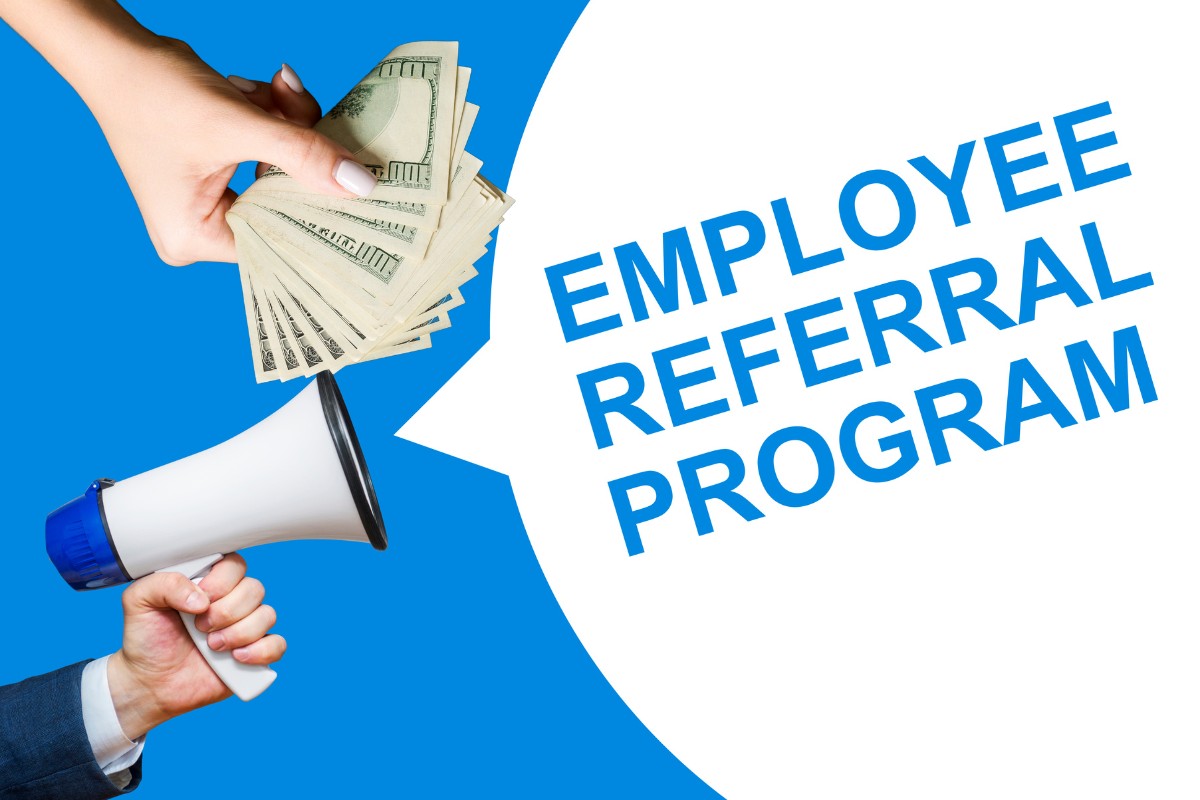One way some companies use to attract the best talent to their job roles involves employee referral programs.
They incentivize current employees to refer applicants to them for various roles in their organization.
In the following employee referral statistics for 2024, we will address how this method of attracting talent is going and other pertinent data.
We will learn how many new hires come from employee referrals, where employee referrals come from, and much more.
Whether you’re a marketer, company, employer, hiring manager, recruiter, employee, or simply curious, you will find these statistics interesting.
You may see something you expected, but then you may also see some surprising statistics about this topic.
Without further ado, let’s get started learning about employee referrals.
Post Contents
- 1 Key Statistics
- 2 Top Employee Referral Statistics in 2024
- 2.1 1. 40% of all hires today are referred by employees
- 2.2 2. 55% of organizations say it’s less expensive to hire employee referrals.
- 2.3 3. 47% of employee referral hires stay more than three years at their job.
- 2.4 4. Only 7% of hires come from employee referrals.
- 2.5 5. 82% of employers depend on the effectiveness of their employee referral programs.
- 2.6 6. 88% of employers say employee referral programs make the best sources for applicants.
- 2.7 7. Employee referral hires take only 29 days to hire.
- 2.8 8. 71% of organizations think that cash bonuses for employee referrals is highly effective.
- 2.9 9. 70% of employers feel that employee referred hires are a better fit for the company.
- 2.10 10. Over the life of a hire, employee referral hires cost employers 41% less.
- 2.11 11. Chances of getting hired as a referral are higher among companies with fewer than 100 employees.
- 2.12 12. Employee turnover rates are up to 20% lower due to hiring employee referrals.
- 2.13 13. Companies use cash rewards 69% of the time to encourage employee referrals.
- 2.14 14. 30% of organizations claim they will invest more in employee referrals.
- 2.15 15. People in the sales industry are most often hired from employee referrals.
- 2.16 16. Only 14% of employees from job board hires stay over three years.
- 2.17 17. 39% of hires from career sites stay with an employer for more than three years.
- 2.18 18. ICIMS shows that referred employees stay an average of 70% longer than non-referrals.
- 2.19 19. Employee referral hires are 25% more profitable to an employer.
- 2.20 20. Hires from employee referrals boost job matches by between 2.6% and 6.6%.
- 3 FAQs
- 4 Conclusion
Key Statistics
- 40% of all hires today are referred by employees
- 55% of organizations say it’s less expensive to hire employee referrals.
- 47% of employee referral hires stay more than three years at their job.
- 40% of new hires come from employee referrals.
- 82% of employers depend on the effectiveness of their employee referral programs.
- 88% of employers say employee referral programs make the best sources for applicants.
- Employee referral hires take only 29 days to hire.
- 71% of organizations think that cash bonuses for employee referrals is highly effective.
- 70% of employers feel that employee referred hires are a better fit for the company.
- Over the life of a hire, employee referral hires cost employers 41% less.
Top Employee Referral Statistics in 2024

1. 40% of all hires today are referred by employees
Most of us know someone who has gotten a job from an employee referral.
Sometimes people call this networking, which is common in the workplace.
Jobvite research revealed that 40% of employees hire today are from employee referrals whether there is a specific employee referral program or not.
(Forbes, The Undercover Recruiter)
2. 55% of organizations say it’s less expensive to hire employee referrals.
Over half of businesses claim that it’s cheaper to hire from employee referrals.
In fact, 55% say that it’s less expensive to hire employee referred job applicants than it is to hire from other sources like job boards, etc.
(Forbes, Clutch)
3. 47% of employee referral hires stay more than three years at their job.
More data from the Jobvite study revealed that 47% of those hired from employee referrals remain with the company for over three years.
Another 46% said they stay for over a year, and 45% over two years.
Career sites and job boards have lower retention rates.
(The Undercover Recruiter)
4. Only 7% of hires come from employee referrals.
Statistics show that 40% of all hires come from employee referrals, yet this comes from only 7% of referral applicants.
This shows the impact and efficacy of employee referral programs.
Also, as we move forward, we will find that referrals offer higher employee retention rates.
(Gitnux)
5. 82% of employers depend on the effectiveness of their employee referral programs.
A whopping 82% of employers claim that they rely heavily upon the efficacy of their employee referral programs.
They say that this is the best recruiting strategy to date since it’s been proven to deliver the best ROI (return on investment).
In fact, employee referrals are among the top recruiting solutions used by modern employers.
(GoRemotely)
6. 88% of employers say employee referral programs make the best sources for applicants.
Not only do 82% of employers depend on effective employee referrals, 88% say they find it to be the best method of attracting top talent to their roles in a company.
Many also believe it’s also a better way to attract candidates that appreciate specific company culture and values.
(Zippia)
7. Employee referral hires take only 29 days to hire.
According to a Jobvite survey, employers say that employee referrals speed up the hiring process.
Most referred hires take only 29 days to get to work.
Job boards and career sites have a 39- to 55-day period for hiring.
(Forbes)
8. 71% of organizations think that cash bonuses for employee referrals is highly effective.

Almost three-quarters (71%) of companies feel that cash bonuses are the most effective way to encourage employee referrals.
Companies also say that paid time off has a 13% share in effectiveness and social praise has 4%.
Only 1% of companies say that donations in the employees’ name is an effective employee referral reward.
You will find out how employees feel about rewards in this area later.
(Clutch)
9. 70% of employers feel that employee referred hires are a better fit for the company.
The Jobvite survey mentioned in this article also showed that 70% of employers feel that their referred hires make a better fit for the company.
This relates to how well the employee fits into the company culture and how they share the same values.
This is another factor that helps employee retention.
(The Undercover Recruiter)
10. Over the life of a hire, employee referral hires cost employers 41% less.
Employers believe that referral hires are most cost effective over the lifespan of the employee that is referred.
In fact, it’s said that hiring employee referrals can cost up to 41% less than hiring people from other sources such as job boards and career sites.
(Gitnux)
11. Chances of getting hired as a referral are higher among companies with fewer than 100 employees.
Data reveals that if you are an employee referral for a company with fewer than 100 employees, your chances of getting hired are the highest.
Smaller companies are often more traditional in terms of having good relationships with their employees.
That level of trust is family-like which means the company trusts employee referrals more than larger companies do.
(GoRemotely)
12. Employee turnover rates are up to 20% lower due to hiring employee referrals.
Today, employee turnover is a big problem across industries.
While it impacts some industries more than others, rates are lower by up to 20% when employers hire from employee referrals.
According to statistics, even if an employer only hires 30% of their employees from current employee referrals, they can reduce their turnover rates by 6%.
(Zippia)
13. Companies use cash rewards 69% of the time to encourage employee referrals.
The statistics say that the most common compensation used for employee referral programs is to use cash rewards.
In fact, cash rewards are used 69% of the time in their employee referral programs.
Social praise has a share of 27% and ties with gift rewards.
Paid time off accounts for 25% of employee referral programs and donations to employees’ favorite charity accounts for 9%.
(Clutch)
14. 30% of organizations claim they will invest more in employee referrals.
The most recent data shows that 30% of businesses plan to invest more in employee referrals.
This data came from a survey in 2011, but it seems to have come to fruition since more companies today have a specific employee referral program in place.
(The Undercover Recruiter)
15. People in the sales industry are most often hired from employee referrals.
Data shows that people in sales are mostly hired by employee referrals.
In fact, the sales industry is where this happens the most.
Moreover, companies with a focus on sales have employee referral programs more often than any other industry.
(Gitnux)
16. Only 14% of employees from job board hires stay over three years.
Earlier we learned that 47% of hires that are referred to the company by existing employees stay for over three years with a company.
In contrast, only 14% of people hired from job boards stay for over three years.
Another 20% was reported to stay over two years and 22% over one year.
Retention rates are the lowest among hires from job boards.
(The Undercover Recruiter)
17. 39% of hires from career sites stay with an employer for more than three years.
According to the Jobvite study, 39% of employees hired from career sites stayed longer than three years with an employer.
This is more than the 14% from job boards, but it stills pales in comparison to the 44% among employee referrals.
Likewise, 35% of career site hires stayed over two years and 33% over one year.
This confirms that employee retention and employee referral hiring is connected.
(The Undercover Recruiter)
18. ICIMS shows that referred employees stay an average of 70% longer than non-referrals.
We already know that hires from employee referrals lower employee turnover and raise employee retention.
Research also shows that employees who have been referred to an employer stay an average of 70% longer than those not referred by employees.
That’s a significant difference.
(ICIMS)
19. Employee referral hires are 25% more profitable to an employer.
We have learned that it costs less to hire an employee referred by another employee, but now we know that this is also 25% more profitable as well.
The numbers show that it costs an average of $1,000 less than other forms of hiring to hire employee referred people.
(Zippia)
20. Hires from employee referrals boost job matches by between 2.6% and 6.6%.

It’s prudent to know that hires from employee referrals also boost job matches by between 2.6% and 6.6% on average.
This means the odds of finding top talent that matches the job role and the applicant’s ideals gets a meaningful boost overall.
This is one of many reasons that human resource managers favor employee referrals.
(GoRemotely)
FAQs
The following frequently asked questions will include a few bonus statistics for you.
How many internal hires are from employee referrals?
According to studies, surveys, and research, up to about 45% of internal hires come from employee referrals.
That accounts for almost half of all internal hires coming from employee referrals.
This says a lot since only 7% of applicants come from employee referrals.
How many interviews are from employee referrals?
Statistics show that 72% of interviews come from employee referrals.
In the world of applying for jobs, referrals have a better chance of getting asked for an interview than non-referrals.
We have learned that only 7% of applicants come from employee referrals, but still account for a whopping 72% of job interviews.
We want to stress how significant employee referrals are.
What is the average amount of an employee referral bonus?
It can cost a company an average of $3,000 to over $5,000 to replace a worker.
The average employee referral bonus comes to about $2,500.
That said, it’s worth mentioning that bonuses for referrals can range from $1,000 to $5,000 depending on the company, job role, etc.
Things like seniority levels and security clearances can have an impact on these bonuses.
How many employees refer their friends?
Data shows that 35% of employees will help their friends and refer them for a job where they work.
Furthermore, 32% say they refer candidates to help their company and 26% do it so they can be seen as a valuable and trusted coworker.
Only 6% of employees refer candidates for recognition and the cash rewards/bonuses.
Do companies prefer employee referrals over other hiring sources?
Yes.
Most companies do prefer hiring from employee referrals over job boards and career sites in general.
We have found some reasons for this for some perspective.
1. Reduced hiring time: It saves roughly 13 days to hire an employee referral.
2. Reduced costs: It can save a company $1,000 or more to hire from a referral within the company.
3. Improved employee retention: Employee referred hires stay an average of 70% longer than hires from other sources. It makes sense to prefer employee referrals based on that data alone.
4. Better company and job fit: Employees at a company usually know how their culture works, the values of the company, and other relevant company information. Therefore, when they refer someone to a job with their company, it’s often a successful match at almost every level.
All these factors were discussed in the statistical section of this article, but they were worth repeating together.
Conclusion
We now have the scoop on the effectiveness of employee referrals in terms of costs, return on investment, profitability, and employee retention versus turnover.
The figures tell a story that it’s more advantageous to hire employee referred candidates.
We also know that employee referrals most commonly make the best fit within a company culture and have similar or the same values as the company hands down.
If you’re a business owner, hiring manager, recruiter, job seeker, employee, or employer, this data should help you improve your overall hiring process and reduce employee turnover which causes a financial burden.
We hope that after reading this employee referral statistics article you have learned some new things and received valuable insights from it.
Sources
| The Undercover Recruiter | Forbes | Zippia | Jobvite 2020 Report |
| Gitnux Blog | GoRemotely | Exploding Topics | Clutch |
| ICIMS |






























